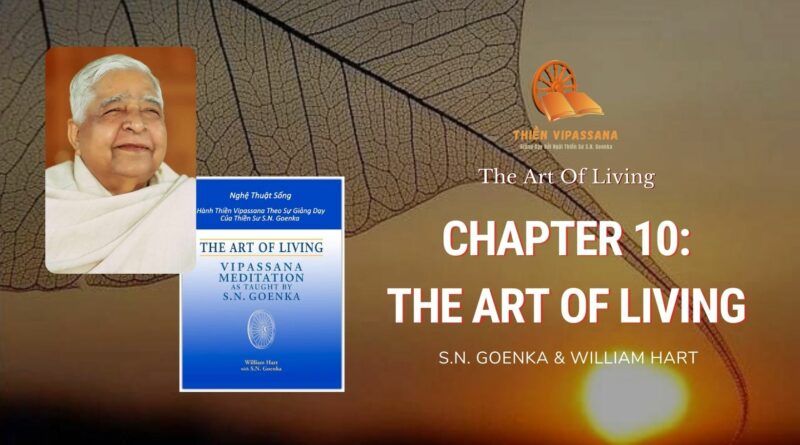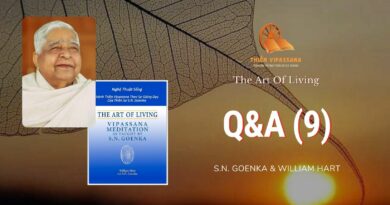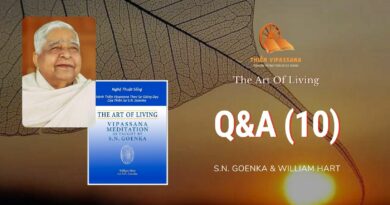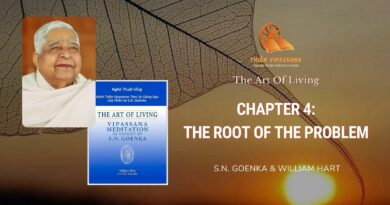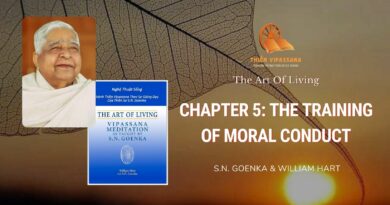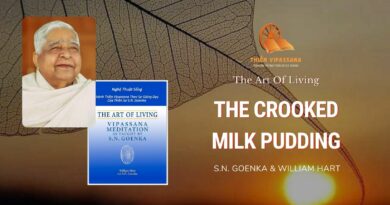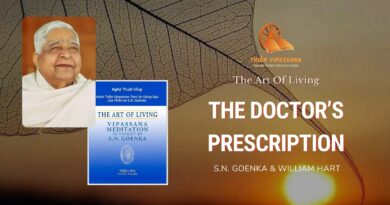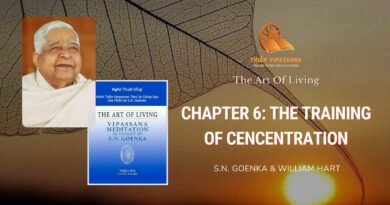Chapter 10. THE ART OF LIVING
Of all our preconceptions about ourselves, the most basic is that there is a self. On this assumption we each give highest importance to the self, making it the center of our universe. We do this even though we can see without much difficulty that among all the countless worlds, this is only one; and among all the countless beings of our world, again this is only one. No matter how much we inflate the self, it still remains negligible when measured against the immensity of time and space. Our idea of the self is obviously mistaken. Nevertheless we dedicate our lives to seeking self-fulfillment, considering that to be the way to happiness. The thought of living in a different way seems unnatural or even threatening.
But anyone who has experienced the torture of self-consciousness knows what a great suffering it is. So long as we are preoccupied with our wants and fears, our identities, we are confined within the narrow prison of the self, cut off from the world, from life. Emerging from this self-obsession is truly a release from bondage, enabling us to step forth into the world, to be open to life, to others, to find real fulfillment. What is needed is not self-denial or self-repression, but liberation from our mistaken idea of self. And the way to this release is by realizing that what we call self is in fact ephemeral, a phenomenon in constant change.
Vipassana meditation is a way to gain this insight. So long as one has not personally experienced the transitory nature of body and mind, one is bound to remain trapped in egoism and therefore bound to suffer. But once the illusion of permanence is shattered, the illusion of “I” automatically disappears, and suffering fades away. For the Vipassana meditator, anicca, the realization of the ephemeral nature of the self and the world, is the key that opens the door to liberation.
The importance of understanding impermanence is a theme that runs like a common strand through all the teaching of the Buddha. He said,
Better a single day of life
seeing the reality of arising and passing away than a hundred years of existence remaining blind to it.1
He compared the awareness of impermanence to the farmer’s plowshare, which cuts through all roots as he plows a field; to the topmost ridge of a roof, higher than all the beams that support it; to a mighty ruler holding sway over vassal princes; to the moon whose brightness dims the stars; to the rising sun dispelling all darkness from the sky.2 The last words that he spoke at the end of his life were, “All saṅkhāras—all created things—are subject to decay. Practise diligently to realize this truth.”3
The truth of anicca must not merely be accepted intellectually. It must not be accepted only out of emotion or devotion. Each of us must experience the reality of anicca within ourselves. The direct understanding of impermanence and, along with it, of the illusory nature of the ego and of suffering, constitutes true insight which leads to liberation. This is right understanding.
The meditator experiences this liberating wisdom as the culmination of the practice of sīla, samādhi, and paññā. Unless one undertakes the three trainings, unless one takes every step along the path, one cannot arrive at real insight and freedom from suffering. But even before beginning the practice one must have some wisdom, perhaps only an intellectual recognition of the truth of suffering. Without such understanding, no matter how superficial, the thought of working to free oneself from suffering would never arise in the mind. “Right understanding comes first,” the Buddha said.4
Thus the first steps of the Noble Eightfold Path are in fact right understanding and right thought. We must see the problem and decide to deal with it. Only then is it possible to undertake the actual practice of Dhamma. We begin to implement the path with training in morality, following the precepts to regulate our actions. With the training of concentration we begin to deal with the mind, developing samādhi by awareness of respiration. And by observing sensations throughout the body, we develop experiential wisdom which frees the mind of conditioning.
And now, when real understanding arises from one’s own experience, again right understanding becomes the first step along the path. By realizing one’s ever-changing nature through the practice of Vipassana, the meditator frees the mind of craving, aversion, and ignorance. With such a pure mind it is impossible to even think of harming others. Instead one’s thoughts are filled only with good will and compassion toward all. In speech, action, and livelihood, one lives a blameless life, serene and peaceful. And with the tranquility resulting from the practice of morality, it becomes easier to develop concentration. And the stronger the concentration, the more penetrating one’s wisdom will be. Thus the path is an ascending spiral leading to liberation. Each of the three trainings supports the others, like the three legs of a tripod. The legs must all be present and of equal length or the tripod cannot stand. Similarly, the meditator must practise sīla, samādhi, and paññā together to develop equally all facets of the path. The Buddha said,
From right understanding proceeds right thought; from right thought proceeds right speech; from right speech proceeds right action;
from right action proceeds right livelihood; from right livelihood proceeds right effort; from right effort proceeds right awareness;
from right awareness proceeds right concentration; from right concentration proceeds right wisdom; from right wisdom proceeds right liberation.5
Vipassana meditation also has profound practical value here and now. In daily life innumerable situations arise that threaten the equanimity of the mind. Unexpected difficulties occur; unexpectedly others oppose us. After all, simply learning Vipassana is not a guarantee that we shall have no further problems, any more than learning to pilot a ship means that one will have only smooth voyages. Storms are bound to come; problems are bound to arise. Trying to escape from them is futile and self-defeating. Instead, the proper course is to use whatever training one has to ride out the storm.
In order to do so, first we must understand the true nature of the problem. Ignorance leads us to blame the external event or person, to regard that as the source of the difficulty, and to direct all our energy toward changing the external situation. But practice of Vipassana will bring the realization that no one but ourselves is responsible for our happiness or unhappiness. The problem lies in the habit of blind reaction. Therefore we ought to give attention to the inner storm of conditioned reactions of the mind. Simply resolving not to react will not work. So long as conditioning remains in the unconscious, sooner or later it is bound to arise and overpower the mind, all resolutions to the contrary notwithstanding. The only real solution is to learn to observe and change ourselves.
This much is easy enough to understand, but to implement it is more difficult. The question remains, how is one to observe oneself? A negative reaction has started in the mind—anger, fear, or hatred. Before one can remember to observe it, one is overwhelmed by it and speaks or acts negatively in turn. Later, after the damage is done, one recognizes the mistake and repents, but the next time repeats the same behavior.
Or, suppose that—realizing a reaction of anger has started—one actually tries to observe it. As soon as he tries, the person or situation one is angry at comes to mind. Dwelling on this intensifies the anger. Thus to observe emotion dissociated from any cause or circumstance is far beyond the ability of most.
But by investigating the ultimate reality of mind and matter, the Buddha discovered that whenever a reaction arises in the mind, two types of changes occur at the physical level. One of them is readily apparent: the breath becomes slightly rough. The other is more subtle in nature: a biochemical reaction, a sensation, takes place in the body. With proper training a person of average intelligence can easily develop the ability to observe respiration and sensation. This allows us to use changes in the breath and the sensations as warnings, to alert us to a negative reaction long before it can gather dangerous strength. And if we then continue observing respiration and sensation, we easily emerge from the negativity.
Of course the habit of reaction is deeply ingrained and cannot be removed all at once. However, in daily life, as we perfect our practice of Vipassana meditation, we notice at least a few occasions when instead of reacting involuntarily, we simply observe ourselves. Gradually the moments of observation increase and the moments of reaction become infrequent. Even if we do react negatively, the period and intensity of the reaction diminish. Eventually, even in the most provocative situations, we are able to observe respiration and sensation and to remain balanced and calm.
With this balance, this equanimity at the deepest level of the mind, one becomes capable for the first time of real action—and real action is always positive and creative. Instead of automatically responding in kind to the negativity of others, for example, we can select the response that is most beneficial. When confronted by someone burning with anger, an ignorant person himself becomes angry, and the result is a quarrel that causes unhappiness for both. But if we remain calm and balanced, we can help that person to emerge from anger and to deal constructively with the problem.
Observing our sensations teaches us that whenever we are overwhelmed by negativity, we suffer. Therefore, whenever we see others reacting negatively, we understand that they are suffering. With this understanding we can feel compassion for them and can act to help them free themselves of misery, not make them more miserable. We remain peaceful and happy and help tthers to be peaceful and happy.
Developing awareness and equanimity does not make us impassive and inert like vegetables, allowing the world to do what it likes with us. Nor do we become indifferent to the suffering of others while remaining absorbed in the pursuit of inner peace. Dhamma teaches us to take responsibility for our own welfare as well as for the welfare of others. We perform whatever actions are needed to help others, but always keeping balance of mind. Seeing a child sinking in quicksand, a foolish person becomes upset, jumps in after the child, and himself is caught. A wise person, remaining calm and balanced, finds a branch with which he can reach the child and drag him to safety. Jumping after others into the quicksand of craving and aversion will not help anyone. We must bring others to the firm ground of mental balance.
Many times in life strong action is necessary. For example, we may have tried to explain in mild, polite language to someone that he is making a mistake, but the person ignores the advice, being unable to understand anything except firm words and actions. Therefore one takes whatever firm action is required. Before acting, however, we must examine ourselves to see whether the mind is balanced, and whether we have only love and compassion for the person who is misbehaving. If so, the action will be helpful; if not, it will not really help anyone. If we act from love and compassion we cannot go wrong.
When we see a strong person attacking a weaker one, we have a responsibility to try to stop this unwholesome action. Any reasonable person will try to do so, although probably out of pity for the victim and anger toward the aggressor. Vipassana meditators will have equal compassion for both, knowing that the victim must be protected from harm, and the aggressor from harming himself by his unwholesome actions.
Examining one’s mind before taking any strong action is extremely important; it is not sufficient merely to justify the action in retrospect. If we ourselves are not experiencing peace and harmony within, we cannot foster peace and harmony in anyone else. As Vipassana meditators we learn to practise committed detachment, to be both compassionate and dispassionate. We work for the good of all by working to develop awareness and equanimity. If we do nothing else but refrain from adding to the sum total of tensions in the world, we have performed a wholesome deed. But in truth the act of equanimity is loud by its very silence, with far-reaching reverberations that are bound to have a positive influence on many.
After all, mental negativity—our own and others’—is the root cause of the sufferings of the world. When the mind has become pure, the infinite range of life opens before us, and we can enjoy and share with others real happiness.
Bài viết này được trích từ cuốn sách The Art Of Living – Thiền Sư S.N.Goenka và William Hart.

